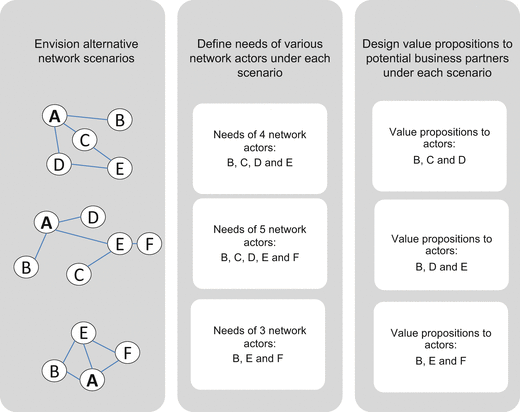I got introduced to network pictures by Valtteri Kaartemo a few years back, and thought it was a cool idea. Since then, I’ve realized — after talking to many startups — that it’s more than a cool idea. It’s actually useful.
That’s because startups routinely overlook their networks and just focus on competitors. They make positioning to competitors, not to collaborators. This can be very detrimental to succeeding, because often the most connected startups do the best: they get the biggest investment rounds, biggest sales deals, etc. They are just liked more.
So you need to network. And using network pictures can help.
What is a network picture?
The idea of a network picture is that you draw your business as a network diagram (i.e., you in the middle as the central node, and other players linked to you as first- or second-degree nodes).
An example of a network picture (source: [1]):

The others in the picture can be any parties with a logical relation to your startup. They can be:
- collaborators
- customers
- investors
- suppliers/vendors
- resellers/distributors
- marketing/business development agencies
- freelancers
- friends and family
- research institutes/universities
- state departments
- entreprenurship societies
- corporations with venture programs
- press/media
- associations/non-profits.
They can be companies or individual people (e.g., influencers, decision makers, etc.).
Basically, those are the actors that your business interacts with (or should interact with). You are not an island.
How do use network pictures for your startup?
Now, the important thing is this: you first draw the current situation, and then the vision. I repeat,
1. Draw current situation
2. Draw vision
—
3. Compare the two
The point is that when drawing the vision, you automatically make apparent your desired state of mind which makes it easier to create a tangible plan for networking. It’s about making the vision explicit.
It also helps you consider possibilities that you had overlooked. Like, “Oh, we should check if the local university has any research projects that coincide with our product development roadmap“. Or, “We could meet up with the industry association people to ask if they find potential in our tech.” Things like that.
Through this process, you (hopefully) realize that you’re not an island, and that there many parties you could (and should) involve in your business at varying degrees of commitment. You can continue by analyzing the motives and win-wins that your connections to current and future parties entail. A good approach has been illustrated in [2]:

Conclusion
Often, business planning for startups focuses on competitors, but collaborators can be even more important. Start by drawing them, and then make the connections happen.
If you’re a startup founder and haven’t thought about the importance of networks, you should. There is research that shows networks and connections matter — and common sense supports this argument, too. You are acting in an ecosystem of other players. It’s the market, not your garage, that matters.
Footnotes:
[1] Kaartemo, V. (2013). Network development process of international new ventures in internet-enabled markets: service ecosystems approach (Doctoral dissertation). Turku School of Economics, Turku, Finland. Retrieved from http://tsenet.fi/wp-content/uploads/2013/11/network-development-process-of-international-new-ventures.pdf
[2] Valjakka T., Kaartemo V., Valkokari K. (2017) Making Sense of Network Dynamics through Network Picturing. In: Vesalainen J., Valkokari K., Hellström M. (eds) Practices for Network Management. Palgrave Macmillan, Cham